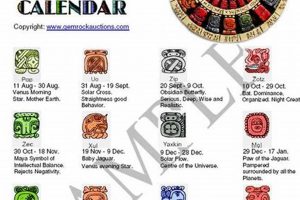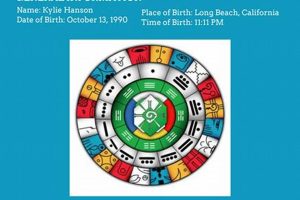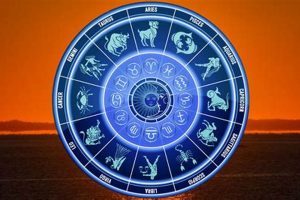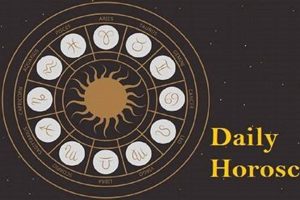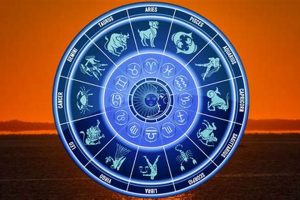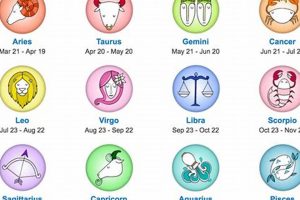This Mesoamerican system combines intricate calendrical cycles with a complex system of beliefs regarding the influence of celestial bodies and time on human affairs. It utilizes several interlocking calendars, including the 260-day Tzolkin (sacred round) and the 365-day Haab (solar year), which synchronize every 52 years, forming a Calendar Round. A third, Long Count calendar, measures time from a mythical creation date, providing a linear timeframe for historical events. Divinatory practices interpret these cycles to understand personality traits, predict auspicious and inauspicious periods, and guide decision-making.
Offering a unique perspective on time and its relationship to human destiny, this ancient tradition provided a framework for understanding the cyclical nature of existence and the interconnectedness of all things. Its enduring legacy lies in its sophisticated astronomical observations and the rich tapestry of symbolism it employed to explain the cosmos. By understanding these cycles, ancient Maya believed they could align themselves with the energies of the universe and live in harmony with its rhythms. This system played a central role in the social, political, and religious life of the Maya civilization.
Further exploration will delve into the specific calendars, their intricacies, and the associated astrological interpretations, offering a deeper understanding of this complex and fascinating system.
Tips for Understanding and Applying Mesoamerican Astrology
These suggestions offer pathways to a deeper appreciation of this ancient system and its potential for self-discovery and informed decision-making.
Tip 1: Learn the basics of the Tzolkin and Haab calendars. Understanding the structure and interplay of these two primary cycles forms the foundation for interpreting their combined influence.
Tip 2: Identify your Day Sign and Year Bearer. These provide insights into personality traits, strengths, and challenges.
Tip 3: Consult resources that explain the meaning of each Day Sign and Year Bearer combination. Numerous books and websites offer detailed interpretations.
Tip 4: Consider the influence of the current energetic cycle. Understanding the energies at play can inform daily choices and long-term planning.
Tip 5: Approach this tradition with respect and an open mind. Appreciating its cultural context enhances understanding and avoids misinterpretations.
Tip 6: Avoid making deterministic predictions. This system offers guidance, not fixed outcomes. Free will remains a significant factor.
Tip 7: Integrate these insights with other forms of self-reflection. Combine this astrological perspective with other practices for a holistic understanding.
By understanding the core principles and applying these insights thoughtfully, one can gain valuable perspectives on personal growth and navigate life’s journey with greater awareness.
This exploration concludes with a reflection on the enduring relevance of this ancient system in the modern world.
1. Calendrical Cycles
Calendrical cycles form the backbone of this Mesoamerican system. Understanding their intricacies is crucial for interpreting astrological meanings and appreciating the broader cultural significance. These cycles provide the framework upon which astrological interpretations are built, offering a complex and nuanced understanding of time’s influence.
- The Tzolkin (Sacred Round)
This 260-day calendar, consisting of 20 day signs and 13 numbers, governs sacred rituals and ceremonies. Each day possesses a unique energetic quality. For example, 1 Imix, the first day of the Tzolkin, represents initiation and new beginnings. The Tzolkin provides insights into personality traits and destiny.
- The Haab (Solar Year)
This 365-day calendar, comprised of 18 months of 20 days each, plus a five-day period known as Wayeb’, tracks the solar year and agricultural cycles. The months align with specific seasonal activities and natural phenomena. For instance, the month of Mol is associated with rain and the planting of maize. The Haab grounds astrological interpretations within the earthly realm.
- The Calendar Round
The synchronized interplay of the Tzolkin and Haab creates a 52-year cycle known as the Calendar Round. A specific combination of a Tzolkin day and a Haab day recurs only every 52 years. This cycle significantly influences individual destinies and societal events. Understanding the Calendar Round provides a deeper perspective on recurring patterns and historical context.
- The Long Count
This linear calendar measures time from a mythical creation date in the distant past. It uses a vigesimal (base-20) system to track extended periods, enabling the dating of historical events. The Long Count provides the broader chronological framework within which the cyclical calendars operate, offering a sense of historical time and continuity.
The interplay of these calendrical cycles forms a sophisticated system for understanding time and its influence on human affairs. This intricate structure provides the foundation for astrological interpretations, divination practices, and ritual observances, reflecting a profound connection between the cosmos and human experience. The system’s complexity allows for nuanced interpretations, moving beyond simple predictions to a richer understanding of cyclical patterns and individual destinies.
2. Astrological Interpretations
Astrological interpretations are integral to this Mesoamerican system, providing a framework for understanding the influence of time and celestial bodies on human experience. The intricate interplay of the Tzolkin and Haab calendars generates a complex web of meanings attributed to each day. These meanings are further enriched by associations with deities, natural phenomena, and directional symbolism. For instance, the day sign Ik, associated with the wind god, might be interpreted as a time for communication and intellectual pursuits. If this day coincides with a Haab month associated with rain, the interpretation might expand to include themes of nourishment and growth, suggesting a fertile period for new ideas and projects.
The significance of astrological interpretations extends beyond individual destinies. They inform communal rituals, agricultural practices, and even political decisions. For example, the alignment of specific days with favorable astrological influences might determine the appropriate time for planting crops or conducting a ceremony to ensure a successful harvest. Historically, rulers consulted astrological advisors to guide their actions, demonstrating the practical application of these interpretations in shaping societal events. Examining these historical practices offers valuable insights into the cultural and societal importance of astrological interpretations within the Mayan world.
Understanding these astrological interpretations provides a crucial lens for comprehending the broader cosmological beliefs and practices of the Maya civilization. This system offers more than simple predictions; it presents a complex framework for navigating the cyclical nature of time and aligning with the energies of the universe. While challenges remain in reconstructing the full depth of these ancient practices, continued research reveals the profound influence of astrological interpretations on the lives and worldview of the Maya people. This exploration of astrological interpretations underscores their central role in the broader system of Mayan calendar astrology and its enduring legacy.
3. Divination Practices
Divination practices played a central role in integrating Mesoamerican calendrical systems into daily life. These practices provided a means of interpreting the perceived influence of cyclical time, as understood through the Tzolkin, Haab, and Calendar Round, on individual and communal affairs. Interpreting specific day signs and their combinations facilitated decision-making across various aspects of life, from agriculture and trade to rituals and warfare. For example, a diviner might consult the calendars to determine an auspicious date for planting maize, ensuring a successful harvest. Alternatively, a ruler might seek guidance on military strategy based on astrologically favorable alignments. These practices highlight the practical application of calendrical knowledge in ancient Maya society.
Several methods facilitated divinatory practices. Trained specialists, often holding significant social and religious authority, employed tools like specialized almanacs and complex calculations to interpret the calendrical cycles. The casting of lots or the observation of natural phenomena, such as the movement of celestial bodies or the behavior of animals, might further inform interpretations. The specific techniques varied regionally and across time, reflecting the evolving nature of Maya cosmology and ritual practices. For example, the use of obsidian mirrors for scrying is documented in certain periods, suggesting a deeper engagement with the spiritual realm through divination.
Understanding the connection between divination practices and these calendrical systems offers crucial insights into the worldview of the ancient Maya. These practices demonstrate a deep belief in the interconnectedness of time, the cosmos, and human destiny. While reconstructing the full complexity of these practices remains challenging due to limited surviving documentation and the inherent complexities of interpreting ancient belief systems, continued research sheds light on the practical and spiritual significance of divination within Maya civilization. This exploration underscores divination’s crucial role in bridging the abstract concepts of cyclical time with the concrete realities of daily life. The ongoing study of these practices offers a window into the intricate ways in which the Maya sought to understand and navigate their world.
4. Ritual Significance
Ritual practice intertwined deeply with Mesoamerican calendrical systems. Specific dates, determined by the intricate interplay of the Tzolkin and Haab calendars, held profound significance for conducting ceremonies. These rituals served to honor deities, commemorate historical events, ensure successful harvests, and maintain cosmic balance. For instance, the New Year ceremonies, tied to specific points in the Calendar Round, involved elaborate rituals to appease the gods and ensure a prosperous year ahead. Similarly, rituals associated with the agricultural cycle, timed according to the Haab’s solar year, aimed to ensure fertility and abundance. The alignment of ritual activity with these calendrical cycles demonstrates their perceived power to influence earthly events and maintain harmony between the human and divine realms.
The specific rituals performed varied depending on the occasion and its corresponding astrological significance. These rituals often involved offerings of food, incense, or even bloodletting, accompanied by prayers, dances, and music. Public ceremonies, often presided over by rulers and priests, reinforced social hierarchies and strengthened communal bonds. For instance, rituals associated with royal accession, timed according to auspicious dates determined by astrological calculations, legitimized the ruler’s power and connected it to the divine order. The careful orchestration of these rituals, guided by calendrical and astrological principles, underscores their importance in maintaining social and cosmic order.
Understanding the ritual significance embedded within this Mesoamerican system provides crucial insights into the worldview and social fabric of the Maya civilization. The cyclical nature of the calendars reflected a belief in the continuous renewal of time and the interconnectedness of all things. While reconstructing the precise details of these rituals poses challenges due to the limitations of surviving evidence and the inherent complexities of interpreting ancient practices, their importance within the broader system remains undeniable. Further research into the relationship between calendrical cycles, astrological interpretations, and ritual practices promises to deepen our understanding of the Maya civilization’s rich cultural and spiritual heritage. This exploration of ritual significance emphasizes its crucial role in shaping Maya society and connecting it to the cosmos.
5. Cosmological Beliefs
Cosmological beliefs formed the foundation upon which the Mesoamerican calendrical system was built. These beliefs provided a framework for understanding the structure and function of the universe, the cyclical nature of time, and the interconnectedness of the cosmos with human existence. This intricate system of beliefs shaped not only the development of the calendars but also the accompanying astrological interpretations, divination practices, and ritual observances.
- The Three Realms
The Maya cosmos was conceptualized as consisting of three interconnected realms: the celestial realm above, the earthly realm of human experience, and the underworld below. The cyclical movements of celestial bodies through the sky were seen as reflections of events occurring in these other realms, influencing the destinies of individuals and communities. For example, the descent of the sun god into the underworld each night symbolized death and rebirth, mirroring the cyclical patterns observed in nature and human life.
- The Sacred Tree
The concept of a World Tree, or Sacred Tree, connecting the three realms played a central role in Maya cosmology. This tree represented the axis mundi, the center of the world, and symbolized the flow of life force between the heavens, earth, and underworld. Specific calendrical cycles and associated rituals were linked to the different levels of the World Tree, reinforcing the connection between time, space, and the sacred.
- Deities and their Influence
The Maya pantheon consisted of numerous deities associated with various natural phenomena, calendrical cycles, and aspects of human life. These deities played active roles in shaping the cosmos and influencing human destiny. For example, Itzamn, the creator god, was associated with the heavens and the day sign Imix, representing new beginnings. The movements of celestial bodies were often interpreted as manifestations of these deities, reflecting their influence on the earthly realm.
- Cyclical Time and Renewal
The cyclical nature of time, as embodied in the interlocking calendars, reflected a core belief in the continuous renewal of life, death, and rebirth. The completion of a calendrical cycle, such as the 52-year Calendar Round, was not viewed as an end but as a return to a previous point, marking a new beginning within the ongoing flow of time. This concept of cyclical time permeated all aspects of Maya life, from agricultural practices to ritual observances.
These cosmological beliefs provided a framework for understanding the interconnectedness of the cosmos and human existence, shaping the development and interpretation of the calendrical system. The calendars were not merely tools for tracking time; they were instruments for understanding the rhythms of the universe and aligning human activities with the divine order. The interplay of cosmological beliefs, calendrical cycles, and astrological interpretations offered a profound and nuanced understanding of the world and humanity’s place within it. This intricate system provided a framework for navigating the complexities of life and finding meaning within the cyclical patterns of time and the cosmos.
Frequently Asked Questions
This section addresses common inquiries regarding this Mesoamerican system, clarifying potential misconceptions and providing concise, informative responses.
Question 1: Is this system a form of predictive astrology?
While it offers insights into potential energies and influences, it functions primarily as a guide for understanding cyclical patterns and aligning with them. Deterministic predictions are discouraged; the system emphasizes free will and personal responsibility within the context of these broader influences.
Question 2: How does it differ from Western astrology?
Unlike Western astrology, which focuses primarily on the position of planets within the zodiac, this Mesoamerican system emphasizes the interplay of several interlocking calendars, each with unique energetic qualities. It offers a different perspective on time and its influence, focusing on cyclical patterns rather than linear progressions.
Question 3: What is the significance of the 260-day Tzolkin calendar?
The Tzolkin, or Sacred Round, is considered the most sacred of the calendars. Its 260-day cycle governs ritual and ceremonial life, providing insights into personality traits, spiritual development, and auspicious timing for various activities.
Question 4: How is the Long Count calendar used?
The Long Count provides a linear timeframe for historical events, measuring time from a mythical creation date. Its structure, based on a vigesimal (base-20) system, allows for the precise dating of events spanning long periods.
Question 5: Are these practices still relevant in the modern world?
Many individuals find value in its insights for self-reflection, personal growth, and understanding cyclical patterns in their lives. While the cultural context has changed, the underlying principles of interconnectedness and cyclical time remain relevant.
Question 6: How can one begin to learn and apply these principles?
Begin by studying the basics of the Tzolkin and Haab calendars. Identify your Day Sign and Year Bearer to gain insights into your personality. Numerous resources, including books and websites, offer further guidance and interpretations. Approach the system with respect for its cultural origins and an open mind.
Understanding the core principles of this Mesoamerican system provides a framework for exploring its rich tapestry of meaning and potential applications.
Further exploration may delve into specific aspects of the system, offering more in-depth knowledge and practical guidance.
Conclusion
This exploration has provided a comprehensive overview of this Mesoamerican system, encompassing its intricate calendrical cycles, astrological interpretations, divination practices, ritual significance, and underlying cosmological beliefs. The interplay of these elements reveals a sophisticated system for understanding time, the cosmos, and human destiny. The system offered the ancient Maya a framework for navigating the complexities of life, making decisions, and aligning with the perceived energies of the universe. From personal guidance to societal organization, the system played a pervasive role in shaping Maya civilization.
The enduring legacy of this system lies not only in its historical and cultural significance but also in its potential to offer contemporary individuals a unique perspective on time and human experience. Further investigation into its intricacies offers opportunities for continued learning and a deeper appreciation of the rich tapestry of human knowledge and belief systems. The system serves as a reminder of the enduring human quest to understand our place within the cosmos and the cyclical nature of existence.


